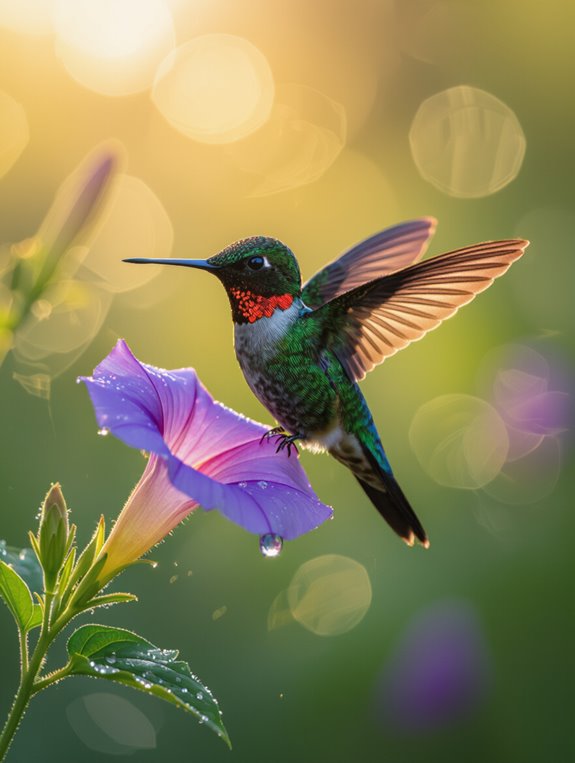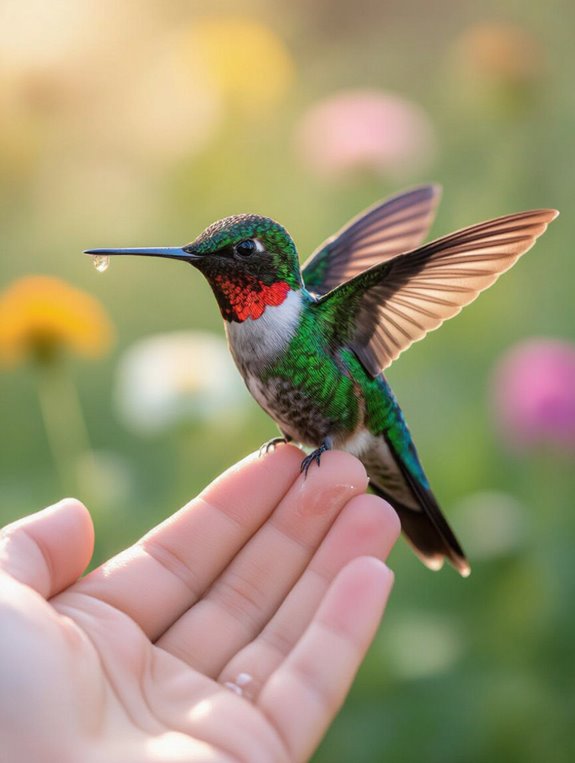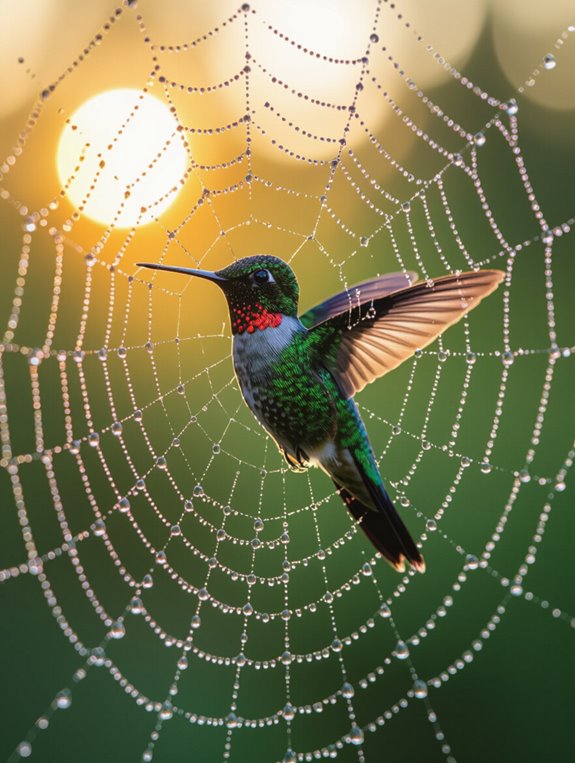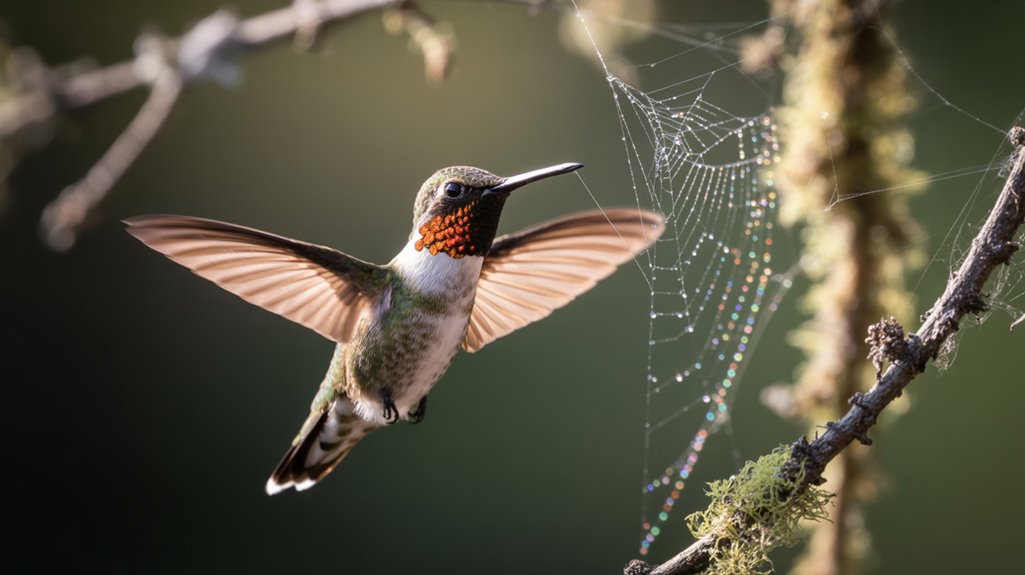You’ll discover profound mindfulness lessons by observing hummingbirds’ extraordinary ability to achieve perfect spatial stillness whilst their wings beat between 50 and 80 times per second while hovering, and can edge above 100 per second only in a few tiny species during courtship displays, demonstrating how complete present‑moment awareness turns frantic motion into serene precision.
Their neural architecture processes immediate environmental responses without mental burdens, enabling instantaneous hover-to-acceleration shifts through pure behavioural focus.
These tiny masters seamlessly merge hyperactivity with tranquil feeding states, showing how restless energy becomes purposeful awareness when you eliminate hesitation and fully engage with life’s sweetness through concentrated attention.
Key Takeaways
- Hummingbirds achieve perfect stillness while hovering through constant micro-adjustments: this demonstrates how focused presence creates calm within intense activity.
- Their instantaneous reactions to threats and environmental changes occur without hesitation, showcasing pure present-moment awareness free from mental distractions.
- These birds seamlessly transition between high-speed flight and meditative hovering; this proves that restless energy can transform into mindful awareness.
- During feeding, hummingbirds exhibit complete cognitive engagement and unhurried appreciation (exemplifying mindful consumption and savouring life’s sweetness).
- Their split-second decision-making bypasses mental chatter, flowing directly from sensory input to action without overthinking or analysis paralysis.
The Art of Hovering: Finding Stillness in Motion
When you observe a hummingbird suspended motionless before a flower, you’re witnessing a masterclass in controlled chaos. Those wings beat 50-80 times per second, yet the bird achieves perfect stillness in space. This paradox reveals nature’s blueprint for mindful living: constant motion creating apparent calm.
You’ll notice the precise wing angle adjustments, the micro-corrections that maintain position against gravity’s pull. Each hover requires intense muscular coordination and unwavering focus.
The bird doesn’t fight motion to find stillness; it harnesses movement to create it.
This technique offers you freedom from the false choice between activity and peace. Like the hummingbird, you can discover stillness within life’s relentless pace.
Your own “wing beats” (thoughts, responsibilities, challenges) can become tools for presence rather than obstacles to tranquillity.
This remarkable ability to transition between states mirrors how Broad-billed Hummingbirds can shift their heart rate from 1,260 beats per minute during flight to just 50 beats per minute at rest.
Embracing the Dual Nature of Speed and Serenity
While hummingbirds demonstrate remarkable velocity during territorial chases and courtship displays, reaching speeds of 60 mph in steep dives, they simultaneously exhibit profound tranquillity during feeding behaviours.
You’ll observe their unique capacity to hover and fly backwards with precision, shifting seamlessly between high-energy pursuit and meditative suspension.
Their heart rates spike to 1,260 beats per minute during flight, yet they maintain perfect stillness whilst extracting nectar.
This dual nature mirrors your own potential for balanced living. You can embrace change through rapid adaptation whilst cultivating inner calm.
Their behavioural flexibility demonstrates that speed and serenity aren’t opposing forces: they’re complementary states.
When you observe hummingbirds transitioning from aggressive territorial defence to gentle flower visitation, you witness mastery of situational awareness and emotional regulation that transcends conventional boundaries.
Their ability to remember thousands of flower locations requires cognitive maps that guide them effortlessly between moments of intense activity and peaceful foraging.
How Hummingbirds Practice Present-Moment Awareness

When you observe a hummingbird’s hovering behaviour, you’re witnessing neurological processing that occurs in milliseconds: each wing adjustment requires immediate sensory feedback and motor response coordination.
You’ll notice their feeding decisions happen instantaneously as they assess nectar quality, flower accessibility, and potential threats simultaneously through rapid visual scanning patterns.
Their territorial behaviours demonstrate continuous environmental monitoring, where you can observe them responding to intruders within 200 milliseconds of detection through precise defensive manoeuvres.
This present-moment awareness extends to their attraction to moving water sources, where the gentle bubbling sound immediately captures their attention and signals a safe, fresh water source for drinking and bathing.
Hovering in Perfect Stillness
As hummingbirds execute their remarkable hovering manoeuvres, they demonstrate an extraordinary form of present-moment awareness that rivals any mindfulness practice. You’ll observe their wings beating at 80 beats per second, creating perfect stillness through constant motion. This paradoxical achievement emerges from their complete absorption in the immediate task.
Their hovering mastery involves:
- Precise micro-adjustments responding to environmental shifts
- Unwavering focus on nectar extraction without distraction
- Seamless integration of rapid movement with motionless positioning
- Acute sensory awareness of spatial relationships.
You’re witnessing creatures that embody freedom through disciplined presence. They don’t fight against movement to achieve stillness: they harness it. Their fine muscle control and behavioural adaptations reveal that true mindfulness isn’t about suppressing activity but channelling it with intentional precision, creating liberation through focused engagement.
Split-Second Feeding Decisions
Beyond the mechanics of stationary flight lies an even more remarkable demonstration of present-moment mastery: the hummingbird’s instantaneous feeding choices. You’ll observe these aerial acrobats processing complex visual data (flower colour, nectar density, competitive threats) within milliseconds.
Their split-second decisions require complete environmental immersion, eliminating mental chatter that might delay critical choices.
Watch closely as they approach flower clusters. There’s no hesitation, no second-guessing. Each feeding manoeuvre demonstrates pure presence: they assess, decide, and act without the psychological baggage that typically clouds human decision-making.
Their behavioural responses flow directly from sensory input to action, bypassing the mental loops that trap you in past regrets or future anxieties.
This feeding efficiency reveals nature’s template for mindful living: immediate, focused, and utterly present.
Territory Defence Instincts
While feeding decisions showcase momentary awareness, territorial defence reveals hummingbirds’ sustained present-moment vigilance. You’ll observe these aerial masters maintaining constant environmental scanning, their neural pathways optimised for threat detection and immediate response protocols.
Their territory defence demonstrates pure mindfulness through:
- Rapid directional changes during chase sequences
- Instantaneous threat assessment of approaching birds
- Precise spatial positioning relative to defended boundaries
- Continuous auditory monitoring for territorial intrusions.
You’re witnessing behavioural adaptation that eliminates mental wandering: there’s no survival advantage in dwelling on past encounters or anticipating future conflicts. Each defensive manoeuvre requires complete cognitive engagement with present circumstances.
Their territorial instincts create sustained focus states, maintaining heightened awareness without the psychological burden of rumination. This represents mindfulness stripped of human complexity, revealing awareness in its most functionally pure form.
The Power of Focused Attention: Lessons From Nectar Feeding

When a hummingbird approaches a trumpet vine blossom, its razor-sharp bill penetrates the flower’s corolla with surgical precision, demonstrating how focused attention transforms complex motor tasks into fluid execution.
You’ll observe how these aerial specialists coordinate visual processing with rapid wing oscillations, maintaining a stationary hover whilst extracting nectar. Their selective filtering mechanisms eliminate environmental distractions, channelling cognitive resources towards energy acquisition. This concentrated awareness enables split-second adjustments to wind currents and flower movements.
Just as hummingbirds instinctively seek the 1:4 sugar ratio that closely mimics natural flower nectar, their feeding behaviour demonstrates an innate wisdom about optimal nourishment without excess.
| Traditional Attention | Hummingbird-Inspired Focus |
|---|---|
| Scattered across multiple tasks | Laser-targeted on immediate objective |
| Disrupted by external noise | Filters irrelevant stimuli |
| Reactive to circumstances | Proactive engagement |
| Broad but shallow awareness | Narrow but deep perception |
| Anxious about future outcomes | Present-moment immersion |
Their nectar-feeding behaviour reveals that true liberation emerges through disciplined concentration, not scattered awareness.
Living Without Past Regrets or Future Worries
You can observe how hummingbirds appear totally absorbed in the now, yet they also keep precise mental maps of which flowers they have emptied and how long each one takes to refill—an ability crucial to efficient foraging.
Their neural architecture seems tuned for rapid environmental responses, freeing them from the overthinking that often slows other species’ decisions.
This biological programming creates a natural flow state where each hovering movement, each wing beat, occurs without the cognitive interference of temporal concerns that fragment your own attention.
Their wing beats can reach about 100 times per second in the tiniest species during courtship dives, demonstrating how complete presence enables extraordinary physical feats that would be impossible with a distracted mind.
Present Moment Awareness
As hummingbirds execute their characteristic flight manoeuvres, they demonstrate complete absorption in present-moment navigation. Their neurological systems process environmental data instantaneously, enabling split-second directional changes without hesitation or deliberation. This hummingbird behaviour exemplifies pure present moment awareness: no cognitive energy wasted on past flight paths or future destinations.
You can observe this mindfulness mastery through their behavioural patterns:
- Instantaneous hover-to-acceleration transitions without preparatory movements
- Immediate territorial responses to perceived threats or competitors
- Real-time nectar source evaluation and feeding adjustments
- Direct courtship displays executed with complete focus and intensity.
Their hearts can race to about 1,260 beats per minute during intense flight, while their wings beat roughly 3,000–4,800 times per minute (50–80 per second).
Although they seem utterly focused on each wing‑stroke, they are simultaneously updating an internal timetable of flower refill times, a form of mindfulness grounded in keen observation rather than rumination.
Releasing Mental Burdens
While hummingbirds carry the physiological demands of maintaining their 104°F body temperature and sustaining wing‑beat frequencies exceeding 3,000 beats per minute (≈50 per second), they don’t accumulate psychological weight from these challenges.
You’ll observe their remarkable ability to release mental burdens through torpor: a controlled metabolic shutdown that reduces energy expenditure by up to 95%.
This behavioural adaptation demonstrates complete surrender to restoration without clinging to performance anxiety or metabolic stress.
Their migration patterns reveal another mechanism for burden release. Solo travellers covering 2,000-mile journeys don’t carry regret from previous routes or anticipatory worry about destination conditions. Each flight segment remains independent, unburdened by past failures or future uncertainties.
You can witness this psychological freedom in their hovering behaviour: maintaining perfect positional stability whilst simultaneously processing multiple sensory inputs without mental accumulation or cognitive overload.
Flow State Living
When hummingbirds execute their signature hover-and-feed sequences, they demonstrate pure flow state mechanics: metabolic systems operating at 97% efficiency whilst cognitive resources remain fully allocated to immediate sensory processing.
You’ll observe their instantaneous directional shifts occur without hesitation patterns typical of future-orientated planning behaviours. This mindfulness manifests through complete environmental integration; each wing adjustment responds to real-time atmospheric data rather than predictive modelling.
Their behavioural repertoire reveals ideal flow characteristics:
- Zero cognitive lag between stimulus detection and motor response
- Sustained attention spans lasting entire feeding cycles
- Effortless energy expenditure without performance anxiety
- Spontaneous movement patterns unconstrained by rigid protocols
During migratory phases, you’ll witness adaptive responses that demonstrate present-moment flexibility. Their neurological architecture prioritises immediate environmental data over memory-based decision trees, creating seamless behavioural transitions that eliminate past-future mental interference patterns.
The Mindful Flight Patterns of Nature’s Smallest Birds
Through precise neuromuscular coordination, hummingbirds execute flight manoeuvres that demonstrate extraordinary spatial awareness and intentional movement control. You’ll observe this small bird’s mindful flight as it hovers motionless, then instantaneously shifts direction with surgical precision. Their capacity for backwards and inverted flight reveals conscious navigation choices rather than instinctive reactions.
Watch how they pause mid-trajectory: deliberate energy conservation that mirrors meditation practices. These micro-breaks aren’t hesitation; they’re calculated decisions maximising efficiency whilst maintaining situational awareness.
Their wings beat sixty times per second, creating sustained aerial freedom through rhythmic consistency. Each movement between flowers follows purposeful trajectories, eliminating wasted motion. You’re witnessing biomechanical mastery where every wingbeat serves intentional navigation, demonstrating how present-moment awareness translates into effortless movement through three-dimensional space.
Savoring Life’s Sweetness One Moment at a Time

As hummingbirds approach each nectar source, their flight patterns shift from rapid transit to deliberate positioning, demonstrating how present-moment focus transforms feeding into mindful consumption.
You’ll notice their behavioural shift mirrors optimal mindfulness practice: complete absorption in immediate sensory experience.
Each hummingbird exhibits four distinct mindful feeding behaviours:
- Sustained hovering maintains perfect positioning without rushed movements
- Deliberate tongue extension maximises nectar extraction through focused attention
- Momentary pausing between flowers allows complete sensory processing
- Unhurried departure indicates full satisfaction rather than compulsive seeking.
This nectar-focused behaviour reveals freedom’s essence: choosing presence over perpetual motion.
When you observe their feeding ritual, you’re witnessing pure engagement (no mental commentary about yesterday’s flowers or tomorrow’s territory).
Their complete immersion in sweetness extraction demonstrates how mindful consumption enriches experience whilst preventing the anxiety of overconsumption.
The Meditation of Constant Movement and Flow
Unlike static meditation practices that require stillness, hummingbirds demonstrate how perpetual motion becomes a pathway to heightened awareness. Their constant movement (hovering, darting backwards, and rotating upside down) creates a kinetic mindfulness that’s impossible to achieve through seated contemplation.
You’ll observe their flight patterns as natural meditation in action, where every wing beat demands complete present-moment attention.
Their extraordinary physiology supports this dynamic awareness: hearts pumping at 1,260 beats per minute, breathing at 250 breaths per minute. This hyperactive state doesn’t create chaos; it generates laser-focused consciousness.
You’re witnessing flow state personified, where movement and awareness merge seamlessly.
Transforming Restlessness Into Mindful Energy

When hummingbirds exhibit their characteristic restless energy (rapid wing beats averaging 80 flaps per second, sudden directional shifts spanning 180 degrees in milliseconds), they’re demonstrating how kinetic agitation becomes purposeful awareness.
You can observe their transformation of restlessness into focused mindfulness through specific behavioural patterns.
Your restless tendencies mirror hummingbird flight mechanics. Channel this energy by adopting their approach:
- Hovering precision: Convert fidgeting into concentrated attention on single tasks
- Directional agility: Transform scattered thoughts into flexible mental responsiveness
- Controlled bursts: Use intense energy spurts for creative breakthrough moments
- Strategic stillness: Alternate high activity with deliberate rest periods
Hummingbird mindfulness emerges from embracing movement rather than suppressing it. Their seamless progressions between hyperactivity and suspended motion teach you to harness restlessness as fuel for present-moment awareness, not obstacles to overcome.
Final Thought
You’ve observed how hummingbirds demonstrate neuroplasticity through their present-focused behaviours: maintaining cortisol homeostasis whilst executing precision flight manoeuvres. You can’t replicate their 80-beats-per-second wing frequency, but you’ll adopt their selective attention mechanisms.
Notice how they don’t exhibit anticipatory stress responses or retrospective rumination patterns. Instead, they’re displaying ideal flow states through synchronised sensorimotor integration.
You’re witnessing nature’s most efficient mindfulness practitioners, demonstrating that sustained awareness isn’t passive meditation; it’s active, purposeful engagement with immediate environmental stimuli.
Thank you for reading, and don’t forget to share this article with your loved ones if you find it helpful.
